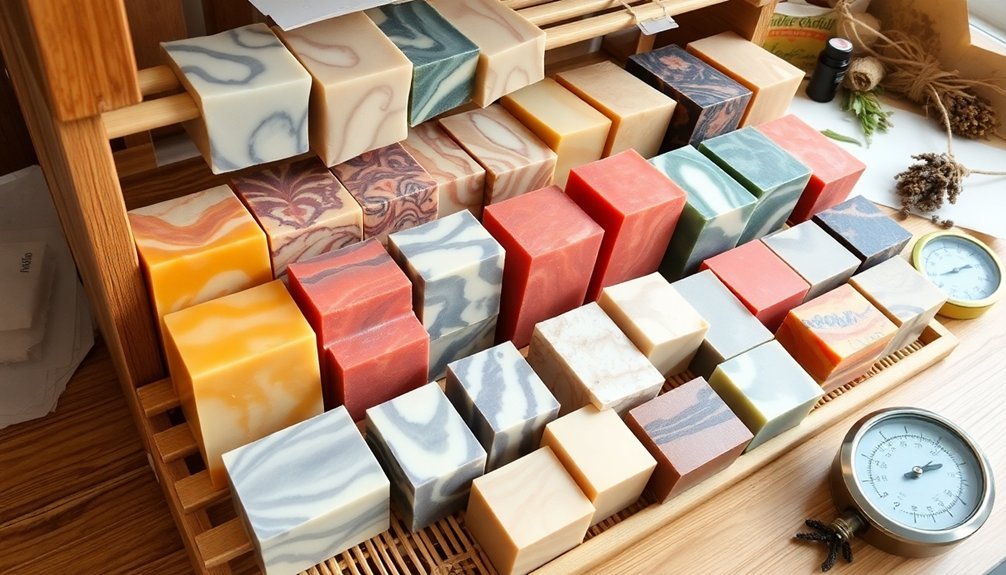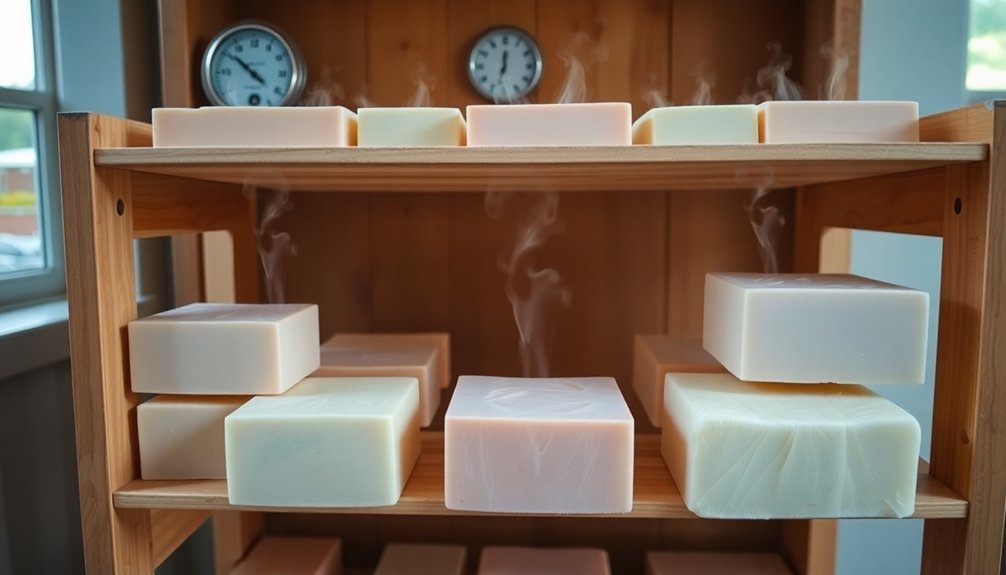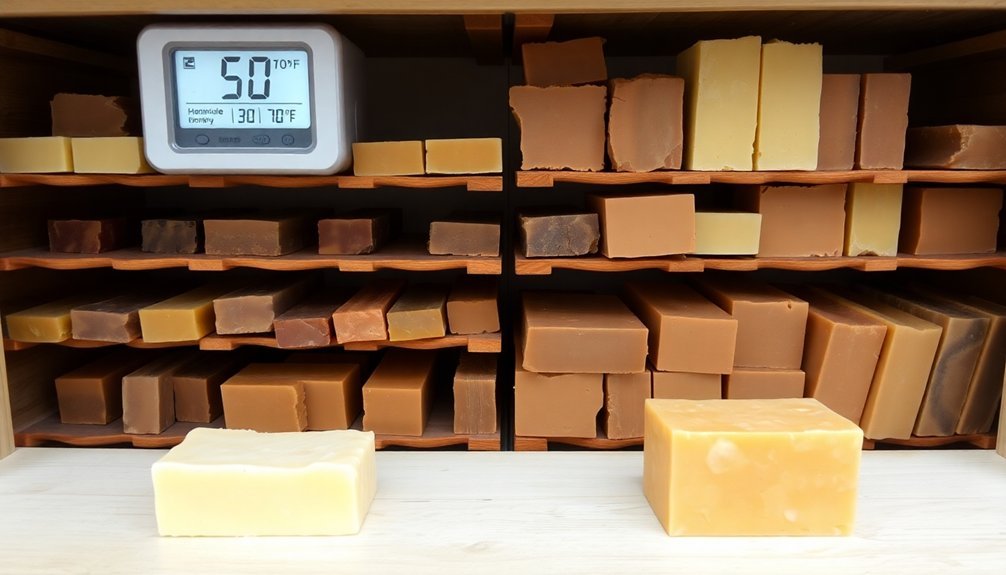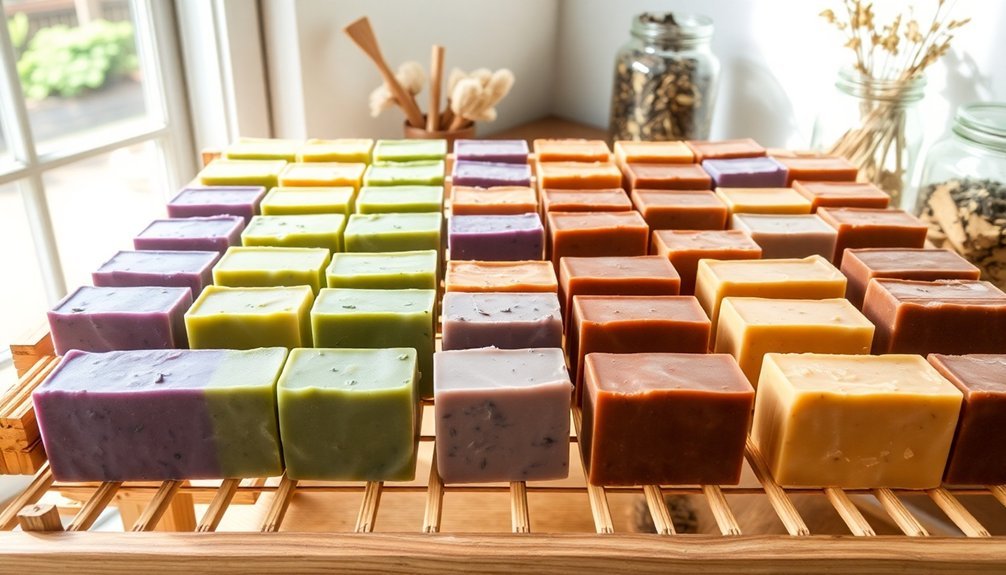To cure handmade soap properly, you'll need to maintain temperatures between 60-80°F, guarantee excellent air circulation with wire racks, space bars at least one inch apart, monitor weight loss weekly to track moisture evaporation, and control humidity with a dehumidifier if needed. Don't wrap soaps in plastic—use breathable materials like muslin instead. Turn bars regularly for even drying. These five techniques will transform your soap from soft and mild to hard, long-lasting bars with superior lather performance.
5 Best Curing Methods For Long-Lasting Handmade Soap

While making homemade soap can be rewarding, proper curing determines its quality and longevity. For best results, store your handmade soaps in a space with temperatures between 60°F and 80°F, which allows residual lye to fully neutralize during the curing process.
Place bars on wire racks to maximize air circulation around each piece, promoting faster moisture evaporation. Avoid plastic wraps that trap water; instead, use breathable materials like muslin if you need to cover them.
High humidity can greatly slow soap curing, so consider using a dehumidifier in damp environments. Track your soap's weight weekly—a stable weight for two consecutive weeks indicates complete curing has occurred.
This methodical approach guarantees excess water evaporates properly, resulting in harder, longer-lasting bars that clean effectively.
The Science Behind Proper Air Circulation for Soap Curing

Air circulation serves as the invisible engine that powers effective soap curing. When you provide optimal airflow around your soap bars by using wire racks, you're accelerating moisture evaporation, which is essential for hardening and preventing mold.
Good ventilation reduces humidity levels that would otherwise extend curing times and compromise your final product's quality.
Don't crowd your soap bars! Spacing them apart guarantees each receives sufficient airflow, leading to uniform drying and faster curing.
Maintain a temperature range of 60°F to 80°F alongside proper air circulation for best results. This combination creates the ideal environment for transforming your freshly made soap into a well-cured product with superior lather quality and longer shelf life.
Your attention to these air circulation principles will greatly enhance your soap's performance.
Optimizing Temperature and Humidity During the Curing Process

Creating the perfect environment for your soap to cure requires careful attention to both temperature and humidity levels. Maintain temperatures between 60°F to 80°F to promote ideal evaporation without compromising your soap's texture or appearance.
High humidity can greatly hinder the drying process, increasing cure time and risking mold growth. You'll want to keep humidity low, especially if you're in naturally humid climates. A dehumidifier is an excellent investment for your curing space, as it removes excess moisture from the air, allowing saponification to complete properly.
Don't overlook air circulation—place your soap bars on wire racks rather than flat surfaces. This allows air to flow around all sides of the bars, accelerating moisture loss and preventing them from becoming soft or sticky.
Regularly monitor conditions and adjust as needed for perfectly cured, long-lasting soap.
Weight Monitoring: Tracking Moisture Loss for Perfect Hardness
Since moisture content dramatically affects your soap's quality, tracking weight loss during curing provides valuable insights into the process. Weighing your soap bars weekly helps you determine when they've reached ideal hardness and are fully cured.
| Week | Expected Results | Action Required | Indicators |
|---|---|---|---|
| 1-2 | Rapid weight loss | Continue curing | Softer texture |
| 3-4 | Moderate loss | Turn bars for even drying | Firming up |
| 5-6 | Minimal loss | Check for stable weight | Nearly ready |
| 7-8 | Stable weight | Ready to use if consistent | best performance |
When you notice consistent measurements over two consecutive weeks, your soap has typically completed the curing process. This evaporation of excess water is essential for longevity and quality. Keep a detailed log to identify how environmental factors like humidity affect moisture loss, allowing you to refine future batches.
Natural Racking Systems That Enhance Soap Quality

The foundation of effective soap curing lies in your racking system's design and implementation. Wire racks provide ideal airflow around your soap bars, allowing moisture to evaporate evenly from all sides.
Space bars at least an inch apart to maximize air circulation and prevent moisture accumulation that could compromise soap quality.
In humid environments, you'll benefit from placing a dehumidifier near your curing area to control humidity levels and accelerate the curing process. This extra step greatly improves soap hardness and longevity.
Once fully cured, shift your bars to breathable storage methods like cardboard boxes, which continue to allow minimal airflow while protecting from dust and light.
Remember to keep these boxes in cool, dry locations away from direct sunlight to preserve fragrances and colors during the final stages of the curing process.
Frequently Asked Questions
How Do You Make Homemade Soap Last Longer?
You'll make homemade soap last longer by curing it 4-6 weeks, storing in cool dry spaces, using a draining soap dish, wrapping in breathable materials, and including hard oils in your recipe.
What Is the Best Way to Cure Homemade Soap?
To cure homemade soap properly, you'll need to store it in a cool, dry place with good air circulation for 4-6 weeks. Use wire racks, avoid plastic wrapping, and monitor weight until it stabilizes.
How to Store Homemade Soap Long Term?
Store your homemade soap in cardboard boxes with breathable wrappings like muslin. Keep it in a cool, dark place between 60-80°F. Don't use plastic wrap as it traps moisture. Check regularly for mold or dampness.
How to Increase the Longevity of Soap?
You'll extend your soap's life by curing it 4-6 weeks, storing it in cool, dry places away from sunlight, using breathable packaging, ensuring good air circulation, and checking regularly for proper hardness.
In Summary
You've now mastered the five essential curing methods that'll transform your handmade soaps from soft creations to long-lasting bars. By understanding proper air circulation, controlling temperature and humidity, monitoring weight loss, and using natural racking systems, you're equipped to elevate your soap-making craft. Remember, patience during the curing process isn't just necessary—it's an investment in quality that your customers will notice and appreciate.





Leave a Reply